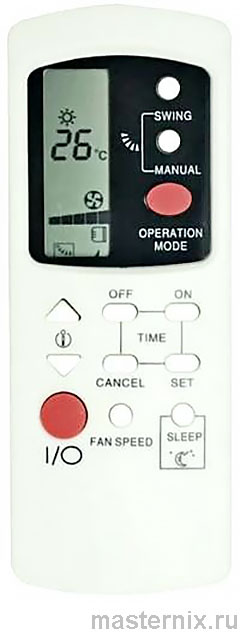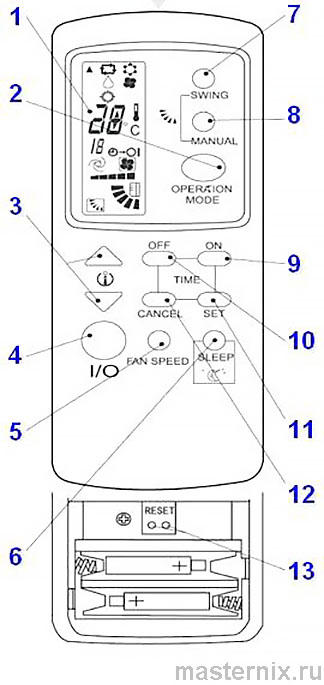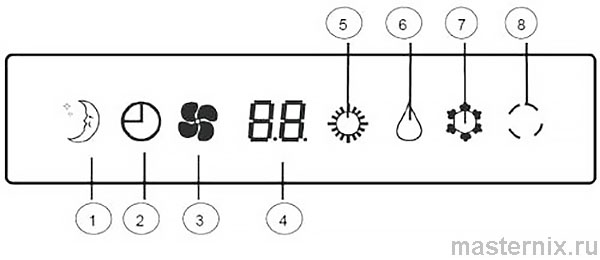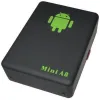
User manual for the remote control of the split-system GZ01-BEJ0-000
Руководство / инструкция

Remote Control for Split-System GZ01-BEJ0-000. Operating Instructions
GZ01-BEJ0-000 Air Conditioner Remote Control Compatibility
The GZ01-BEJ0-000 remote control is compatible with:
Galanz KUDO Series Wall-Mounted Air Conditioners (R410A refrigerant)
GIOWI09RK3
GIOWI12RK3
GIOWI09RK16
GIOWI12RK16
GIOWI18RK16
GIOWI24RK16
GIWI09RK3/16 - Inverter
GIWI12RK3/16 - Inverter
GIWI18RK16 - Inverter
GIWI24RK16 - Inverter
Galanz VIVA Series Wall-Mounted Air Conditioners (R22 refrigerant)
GIOW07RV5
GIOW09RV5
GIOW12RV5
GIOW18RV8
GIOW24RV8
GIOW07RG24
GIOW09RG24
GIOW12RG24
GIOW18RG24
GIOW24RG2
GIOW30RG2
GIOW36RG2
Galanz GALAXY Series Wall-Mounted Air Conditioners (R22 refrigerant)
GIW24RG2
GIW30RG2
GIW36RG2
\
Galanz SEMI-INDUSTRIAL AIR CONDITIONERS Indoor Units Cassette Type (R410A refrigerant)
GC-18HRT/U
GC-24HRT/U
GC-36HRST/U
GC-48HRST/U
Galanz SEMI-INDUSTRIAL AIR CONDITIONERS Indoor Units Floor-Ceiling Type (R410A refrigerant)
GU-12HRT/AU
GU-18HRT/AU
GU-24HRT/AU
GU-36HRST/AU
GU-48HRST/AU
GU-60HRST/AU
Galanz SEMI-INDUSTRIAL AIR CONDITIONERS Indoor Units Duct Type (R410A refrigerant)
GD-18HMRT/U
GD-24HMRT/U
GD-36HMRST/U
GD-48HMRST/U
GD-60HMRST/U
GD-36HTRS/U
GD-48HTRS/U
GD-60HTRS/U
Precautions
- The remote control is not a toy. Do not allow children to play with it.
- When using the remote control, point it towards the indoor unit of the air conditioner. A short beep confirms that the signal has been received.
- The remote control signal is received at a distance of up to 8 meters in a straight line from the indoor unit at an angle of 45° to the left and right. There must be no obstacles between the remote control and the unit.
- Keep the remote control at least 1 meter away from televisions and radios.
- Do not drop the remote control or expose it to impacts. Protect it from sunlight, heat, water, and high humidity.
- Do not use sharp objects to press the buttons. Do not clean the remote control with gasoline, solvent, or chemically treated wipes.
- If the remote control does not work, remove the batteries, wait 30 seconds, and reinsert them. If this does not help, replace the batteries.
❗👉➨ - Important! Remove the batteries if the remote control will not be used for an extended period.
❗👉➨ - Attention The manufacturer reserves the right to make changes to the design, configuration, or manufacturing technology of the remote control without prior notice.
\
Description of the GZ01-BEJ0-000 Remote Control Buttons
The image shows a standard remote control with all functional buttons indicated. Depending on the model, the buttons on your remote control may differ slightly.

1. Operating Display
Displays the current mode and settings.
2. Operating Mode
[ AUTO ] - automatic mode
[ COOL ] - cooling mode
[ DRY ] - dehumidification mode
[ FAN ] - ventilation mode
[ HEAT ] - heating mode
3. Temperature Adjustment
Pressing the button once changes the temperature by 1°C. Temperature adjustment range: 16–31°C.
4. ON/OFF
Turns the unit on or off.
\
5. FAN SPEED
Selects the fan speed of the indoor unit.
Each press of the button changes the fan speed in the following sequence:
Low – Medium – High – Automatic.
6. SLEEP
Used during sleep. Pressing the button either enables or disables this function. Operates only in Cooling, Dehumidification, and Heating modes.
7. SWING
Airflow direction oscillation mode. Pressing the button either enables or disables this function.
8. MANUAL
Manual adjustment of the airflow direction.
Each press of the button changes the louver position by a specific angle:

9. ON TIMER
This button is used to activate the ON Timer function.
10. OFF TIMER
This button is used to activate the OFF Timer function.
11. SET TIMER
Stores the set values.
12. CANCEL TIMER SETTINGS
Clears the set values.
\
13. REMOTE CONTROL RESET
Reset your remote control by connecting these two points with a metal object if it does not respond to button presses.
❗👉➨ NOTES:
- Heating mode is only available in systems equipped with this function.
- The effective operating distance of the remote control is 6 meters in a straight line without interference.
- If the remote control will not be used for a long time, remove the batteries.
- In the illustration, all functions are shown on the display simultaneously for demonstration purposes. On some models, certain functions shown on the display may not be available.
- Do not subject the batteries to mechanical or thermal impact, as this may cause the remote control to fail.
OPERATING MODES
Automatic On/Off Function by Timer (Preset Time)
A. To set the automatic shutdown of an operating air conditioner using the timer, press the OFF button on the wireless remote control. The  → ◯ icon will start flashing on the display.
→ ◯ icon will start flashing on the display.
To set the automatic start of a switched-off air conditioner, press the ON button on the remote control. The  → I icon will start flashing on the display.
→ I icon will start flashing on the display.
B. Each press of the ON or OFF button on the remote control increases the ON or OFF time by 1 hour (maximum value — 12 hours). This information will be displayed on the screen.
C. To confirm the set ON/OFF time, press the SET button. The icon on the remote control will stop flashing.
Canceling the Preset Automatic On/Off Timer
To cancel the previously set automatic ON/OFF time, press the CANCEL button on the remote control. The  → ◯ or
→ ◯ or  → I icon will disappear from the display.
→ I icon will disappear from the display.
❗👉➨ NOTES
- If there was a power outage, the automatic ON/OFF time will not be saved and must be set again.
- After the automatic ON/OFF time has been set and confirmed by pressing the SET button, it can only be changed by canceling it with the CANCEL button and setting it again.
- If, after the automatic ON/OFF time has been set and confirmed by pressing the SET button, the SET button is pressed again, the countdown will restart.
.
Operating Modes — Parameter Adjustment
AUTOMATIC Mode — AUTO
In this mode, the air conditioner will automatically maintain a comfortable indoor temperature. After switching on, the air conditioner will operate in one of the following modes depending on the room temperature (see table):
| Room Temperature (RT) | Air Conditioner Mode |
| RT ‹ 20°C | Heating (for air conditioners without heating function — Dehumidification mode) |
| 20°C ‹ RT ‹ 24°C | Fan RT › 24°C Cooling |
COOLING Mode
Press the MANUAL SWING or SWING button to change the vertical airflow angle or switch to oscillation mode.
The airflow speed is adjusted by pressing the FAN SPEED button on the remote control.
The temperature is adjusted using the temperature control buttons on the remote control within the range of 16 to 31°C.
DEHUMIDIFICATION Mode — DRY
In this mode, the air conditioner automatically sets the indoor temperature. The temperature value is not displayed. Temperature and airflow speed adjustment is not available in this mode.
FAN Mode
In this mode, the outdoor unit does not operate.
The modes and airflow direction can be adjusted using the MANUAL SWING and SWING buttons.
The fan speed can be adjusted using the FAN SPEED button.
HEATING Mode — HEAT
The airflow direction can be adjusted using the MANUAL SWING and SWING buttons.
The airflow speed is adjusted using the FAN SPEED button.
The temperature is adjusted using the temperature control buttons on the remote control within the range of 16 to 31°C.
SLEEP Mode
SLEEP Mode in Cooling and Dehumidification Modes:
1. The fan operates at the lowest speed.
2. After 1 hour of operation, the maintained temperature increases by 1°C. After another hour, the temperature increases by another 1°C, for a total increase of 2°C, and is maintained at that level.
SLEEP Mode in Heating Mode:
1. The fan operates at the lowest speed.
2. After 1 hour of operation, the maintained temperature decreases by 2°C. After another hour, the temperature decreases by another 2°C, for a total decrease of 4°C, and is maintained at that level.
\
Liquid Crystal Display (LCD) of the Indoor Unit

1. SLEEP mode indicator
2. Automatic ON/OFF timer mode indicator
3. FAN mode indicator
4.1. In normal mode, displays the room temperature
4.2. While adjusting the temperature in COOLING or HEATING mode, blinks to display the set temperature. After 10 seconds, returns to room temperature display mode.
4.3. While setting the timer, displays the set time. After 10 seconds, returns to room temperature display mode.
4.5. If a system malfunction occurs, the LCD displays an error code
5. HEATING mode indicator
6. DEHUMIDIFICATION mode indicator
7. COOLING mode indicator
8. Remote control signal receiver
Error Codes (Displayed on the LCD)
| No. | Code | Fault | Cause | Description and Troubleshooting |
| 1 | A0 | No power supply | Phases are mixed or one phase is missing. | Identify the cause and correct the wiring. |
| 2 | C0 | Control circuit fault | Control circuit wire not connected | Securely connect the control circuit wires. |
| 3 | C1 | Data transmission error between indoor and outdoor units | Data transmission signal form issue | Contact the nearest service center. |
| 4 | E1 | Room temperature sensor malfunction | Room temperature sensor malfunction | Disconnect power, check the sensor connection, replace the faulty sensor. |
| 5 | E2 | Indoor unit heat exchanger temperature sensor malfunction | Sensor malfunction | Disconnect power, check the sensor connection, replace the faulty sensor. |
| 6 | E4 | Outdoor unit heat exchanger temperature sensor malfunction | Sensor malfunction | Disconnect power, check the sensor connection, replace the faulty sensor. |
| 7 | H1 | Outdoor unit malfunction | Outdoor unit malfunction | Identify the cause based on the outdoor unit display signals. |
| 8 | H2 | Overload protection triggered — high compressor pressure | Excessively high outdoor temperature; blocked air intake; dirty air filter | Identify and eliminate the cause. |
| 9 | H3 | Overload protection triggered — low compressor pressure | Excessively low outdoor temperature; significant refrigerant leak; low pressure at the compressor inlet | Identify and eliminate the cause. |
| 10 | P1 | Indoor unit anti-freeze protection activated | Indoor unit heat exchanger icing | Wait, automatic recovery |
| 11 | P2 | Indoor unit overheating protection activated | Indoor unit overheating | Wait, automatic recovery |
| 12 | P3 | Cooling mode — outdoor unit overheating protection activated | Protection activated | Wait, automatic recovery |
| 13 | FF | System failed to start | Protection activated | Switch the system off and on. |
| 14 | P6 | Outdoor air too cold in heating mode | Protection activated | Wait, automatic recovery |
| 15 | P7 | Outdoor unit heat exchanger icing in heating mode | Protection activated | Wait, automatic recovery |
| 16 | PS | Crankcase heater operation indicator | Compressor protection activated | Wait, automatic recovery |
| 17 | CF | Dirty filter indicator | Filter contamination | Turn off the system and clean the filters. |
\
NOTE
If the system is additionally equipped with a wall-mounted wired control panel, this panel can receive signals from the wireless remote control. The display of such a panel may show the following errors:
| No. | Fault | Light Indicator |
| 1 | Power supply failure | Sequence of 1 flash with a 3-second pause |
| 2 | Outdoor unit heat exchanger temperature sensor malfunction | Sequence of 4 flashes with a 3-second pause |
| 3 | Compressor overload protection activated | Sequence of 5 flashes with a 3-second pause |
| 4 | Compressor overload protection — high pressure | Sequence of 6 flashes with a 3-second pause |
| 5 | Compressor overload protection — low pressure | Sequence of 7 flashes with a 3-second pause |
| 6 | Outdoor unit compressor protection activated | Sequence of 8 flashes with a 3-second pause |
EMERGENCY MODE
If the control unit indicates a malfunction, the indoor unit of the air conditioner has an emergency shutdown button. Pressing this button switches the air conditioner as follows:
AUTO Mode → COOLING Mode → STOP
❗👉➨ NOTE
If the control unit is switched on, the emergency shutdown button does not work. To operate the button, it is necessary to remove the control unit, then turn the air conditioner off and on.
Related articles:
GZ-1002B-E3 Air Conditioner Compatibility
Air Conditioners: Basic Functions and Modes
TIMER Function in Air Conditioners
TIMER
SLEEP Night Mode
TURBO Intensive Mode in Household Air Conditioners
SWING Function
Automatic Mode AUTO

